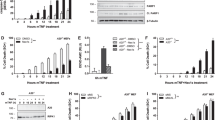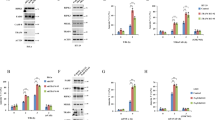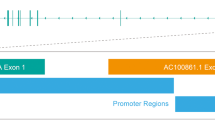Abstract
We and others have shown that the control of TNF-α-induced apoptosis by NF-κB/Rel transcription factors involves suppression of the JNK enzyme cascade1,2,3, and we have proposed that this suppression is mediated in part by Gadd45β/Myd118 (refs 1,4). Amanullah et al. suggest that the ablation of gadd45β has no effect on JNK activation and apoptosis by TNF-α and argue that the protective effects of NF-κB are mediated by factors other than Gadd45β.
Similar content being viewed by others
De Smaele et al. reply
However, caution is needed in drawing inferences from these provocative findings about the role of Gadd45β in the cell. Under the conditions used by Amanullah et al., knockout mutation of any of the NF-κB targets identified so far5,6 — including those of the putative JNK inhibitor XIAP (ref. 7) and of NF-κB/RelA itself8 (our unpublished observations) — would not have affected TNF-α-induced killing. This is because cytokine treatment of fibroblasts was far too short and was performed in the absence of low doses of cycloheximide (about 0.1 μg ml−1; ref. 1) , which is needed to downregulate functionally redundant factors.
Our antisense experiments1 indicate that in certain cells, such as lymphoid cell lines, downregulation of gadd45β leads to exaggerated JNK signalling and apoptosis in response to TNF-α. It is likely that the pro-survival programme that is activated by NF-κB depends on tissue-specific elements5,6, so the relevance of Gadd45β to this protective activity of NF-κB might be more marked in certain cell types. As the analysis of Amanullah et al. is limited to the fibroblastoid lineage, it might not be appropriate to generalize conclusions about the effects of Gadd45β on the JNK pathway and apoptosis to other cell types. We agree with Amanullah et al. that further investigation is needed to define the precise contribution of this factor and of other targets to the anti-apoptotic function of NF-κB.
References
De Smaele, E. et al. Nature 414, 308–313 (2001).
Tang, G. et al. Nature 414, 313–317 (2001).
Javelaud, D. & Besancon, F. Oncogene 20, 4365–4372 (2001).
Franzoso, G., Zazzeroni, F. & Papa, S. Cell Death Diff. 10, 13–15 (2003).
Baldwin, A. S. J. Clin. Invest. 107, 241–246 (2001).
Karin, M. & Lin, A. Nature Immunol. 3, 221–227 (2002).
Harlin, H., Reffey, S. B., Duckett, C. S., Lindsten, T. & Thompson, C. B. Mol. Cell. Biol. 21, 3604–3608 (2001).
Beg, A. A. & Baltimore, D. Science 274, 782–784 (1996).
Author information
Authors and Affiliations
Corresponding author
Rights and permissions
About this article
Cite this article
Zazzeroni, F., Papa, S., De Smaele, E. et al. Cell survival and a Gadd45-factor deficiency. Nature 424, 742 (2003). https://doi.org/10.1038/424742a
Issue Date:
DOI: https://doi.org/10.1038/424742a
This article is cited by
-
Current insights into the regulation of programmed cell death by NF-κB
Oncogene (2006)
-
The NF-κB-mediated control of the JNK cascade in the antagonism of programmed cell death in health and disease
Cell Death & Differentiation (2006)
-
To be, or not to be: NF-κB is the answer – role of Rel/NF-κB in the regulation of apoptosis
Oncogene (2003)
Comments
By submitting a comment you agree to abide by our Terms and Community Guidelines. If you find something abusive or that does not comply with our terms or guidelines please flag it as inappropriate.



